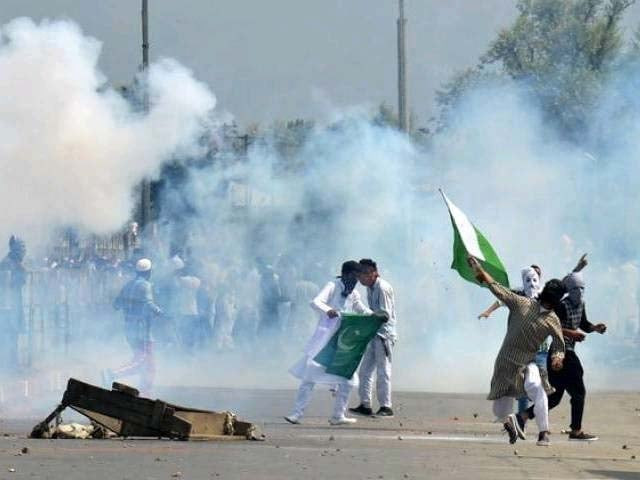In Why Did the ‘Twitter Revolutions’ Fail?, an article published in the New York Times last year, Ivan Krastev couches his set of arguments in a thought-provoking manner by referring to history. He writes that, immediately after the 1851 Paris coup by Napoleon, some of the greatest political minds from Europe, including Karl Marx (a communist), Pierre Joseph Proudhon (an anarchist), Victor Hugo (a romantic), Alexis de Tocqueville and Walter Bagehot (the liberals) hustled to their reading rooms to understand the Paris coup and draw philosophical conclusions out of such events. To quote Ivan,
“Their interpretations of the coup were as different as their philosophies. But in the manner of the man who mistook his wife for a hat, they all mistook the end of Europe’s three-year revolutionary wave for its beginning.”
In a much similar vein, some of the recent articles produced to interpret the on-going mass uprising in Kashmir have more or less reached the same incredulous and unrealistic conclusions. Some noted scholars have argued (at least in the Indian media) that it’s the Pakistani ISI agents masquerading as stone pelters in Kashmir who cause unrest and damage state property.
A few would graciously describe it as a mere human rights issue and claim that the resolution of the Kashmir imbroglio lies in the revocation of the draconian Armed Forces Special Powers Act (AFSPA). And a handful of intellectuals had circumscribed their narratives to the ‘economic disempowerment’ and lack of education thesis. They emphasise that the issue will die down if India keeps pumping money (black or white) into the wallets of the Kashmiri people.
Certainly, there are many other well-balanced writers and intellectuals around the world who sincerely support the Kashmir cause. However, some of them still try to reduce the Kashmir issue to a mere AFSPA problem. Of late, these ‘sympathetic outsiders’ (and sometimes insiders) have been associating the Kashmir issue with the Dalit predicament in India. In their ‘cleverly’ worded articles and by using various arrangements of intellectual rhetoric, they uphold that the solution of the Kashmir problem lies in the liberation of Balochistan and in the emancipation of Dalits in India.
Beyond all doubt, and far from being against Dalit emancipation, I stand for the rights of all suppressed communities around the world irrespective of race, gender or religious denominations. However, the problem arises when we attempt to explore these different issues through one particular framework. By doing this, we are certainly creating more problems than solving any. It is because these differing problems are completely grounded in varied socio-politico and historical settings and can seldom be reduced to one single narrative.
These analysts no doubt have every right to perceive and interpret the happenings in Kashmir in their own way, but this article seeks to offer an insider’s perspective of the on-going struggle.
To interpret a mass revolution and draw conclusions is not an easy task. As reflected above, it has baffled many great intellectuals let alone newspaper columnists. And my humble attempt to read the on-going movement is no exception here. I, myself, could be misinformed and might fail to capture its true essence.
In today’s world we bear witness to many revolutions; small and big, peaceful and violent, driven mostly by the young and the tech-savvy individuals. Thomas L Friedman would term them as ‘The Square People’. In his 2014 New York Times article, he described these people as “young, aspiring to a higher standard of living and more liberty, seeking either reform or revolution”. However, forecasting the fate of these revolutions has become more difficult than ever.
Many would argue that these square revolutions are nothing but merely anarchic and chaotic crowds. For instance, the noted journalist Simon Jenkins, in an article published in The Guardian in February 2014, would contend that present day square revolutions around the globe symbolise failure, not hope. He claims that the motives behind such revolutions are essentially negative, those that oppose power.
“Crowds destroy but seldom build” asserts Jenkins.
Coming back to Kashmir, one could also discern that these Jenkins-like arguments are mostly propounded by state planted writers and paid intellectuals who would argue that the on-going movement is nothing but a kind of muddled and rebellious struggle funded and fuelled by Pakistan. This is far from the truth. The reality is that, for the first time, Kashmir is witnessing a synchronous struggle which is not confined to urban squares but is ubiquitous in all corners of the Kashmir valley, including Chenab and Ladakh. Aptly described by A G Noorani, this is a revolt against India, not one of the “periodic” eruptions in Kashmir.
Furthermore, we are cognisant of the fact that some of the most successful revolutions (like the ones witnessed in Cuba and Nicaragua) were initially driven by small, urban, radicalised youths. However, what we are witnessing in Kashmir today is dissimilar in nature. Yes, young and energetic, but not-so-radicalised youth (far from urban settings or bourgeoisie background) are bidding to give a new direction to the on-going movement. It appears to be a people’s revolution that is mostly concentrated in the rural areas.
However, the commonality among those successful revolutions (like Cuba) and Kashmir lies in the support system offered by the peasants, farmers and rural people to its ‘guerrilla forces’. In both cases, villages have offered varied forms of assistance to its “guerrilla” forces when it was needed. In fact, Burhan Wani, a commander of the Kashmir-based Hizbul Mujahideen who was killed in an encounter with the Indian security forces on July 8, 2016, is widely celebrated as the rural ‘Che’ of Kashmir. He was born and raised in a village in District Pulwama. For more than six years he survived untraced in the rural settings of southern Kashmir.
Notwithstanding the positives of the on-going movement, one cannot shy away from pointing out certain flaws visible in the movement. First and foremost, a severe disconnect between the Kashmir intelligentsia and the people who fight on the streets is very apparent. Certainly, many writers, columnists and academics have produced a number of articles and well-argued papers but, given the esoteric nature of most of these publications, the message seldom reaches the masses.
This disconnect can also be explained in other ways.
First, many genuine writers do not want to contribute out of fear of being apprehended. Second, a sizeable number of good writers are co-opted and are put on different state pay rolls. They are bestowed with foreign fellowships and are entitled to various other prized positions. Third, a few of them are conveniently not offered a space where they can contribute.
This disconnect has greatly affected the on-going movement. To invoke the famous American political scientist Samuel P Huntington here, revolutions have been characterised by an alliance between the intellectuals and the peasants, united by a common objective such as nationalism, something that is critically out-of-place in Kashmir.
Second, the movement seems to be creating its own classes. For example, different groups of ‘conflict bourgeoisie’ in various forms are emerging. They overtly represent the ‘intellectual class’ with different forms like ‘peace lovers’ and ‘cultural activists’ but clandestinely they are working hand-in-glove with the state. Knowingly, they are strengthening the state narrative of the Kashmir imbroglio. That is why most of them are received with high admiration by various forums within and outside India.
Third, the leadership of the resistance movement has utterly failed in finding new ways of resolving this long pending conflict. They stick to the same old hackneyed road maps full of strikes. It seems that the entire leadership is circumscribed to calendar politics entirely. This approach of leading a movement has certainly diminished all the chances of exploring any out-of-the-box solutions. Educated and well-trained youths are seldom attracted and new leaders are hardly ever nurtured in the separatist camp.
It seems as though the leadership of the movement is restricted to a few individuals and not to the institutions. Thus, individuals appear significant, not institutions. To conclude with what Fidel Castro had argued; a ‘plan of action’ is a prerequisite for a successful revolution, which is perhaps still a far dream where Kashmir is concerned.



COMMENTS
Comments are moderated and generally will be posted if they are on-topic and not abusive.
For more information, please see our Comments FAQ